Space
Can humans endure the psychological torment of living on Mars?
Published
4 weeks agoon


Can humans endure the psychological torment of living on Mars?
Alyssa Shannon is a registered nurse at UC Davis Medical Center. One day, on his way to the university hospital, NASA called him and told him that he had been selected for a mission to Mars. That same morning, Nathan Jones, an emergency room physician in Springfield, received a similar call. He immediately thought of his family and told himself that if you accept this opportunity, you will have to let them go. However, he couldn’t turn down NASA’s opportunity and convinced himself that Mars was his destiny.
The Mars Crew Health and Performance Probe Analogue Mission, or CHAPEA, will not actually send selected individuals to Mars, but rather will accurately simulate the first human journey to Mars and pave the way for sending the first humans to Mars, possibly by 2040. .
According to NASA, humans will one day travel to Mars. In 2018, NASA estimated that the first humans would land on Mars “by the late 2020s at the latest.” The date for the first human mission has changed slightly, but despite the technical hurdles, it will definitely happen one day. Rachel McCulley, until recently the deputy director of NASA’s Mars campaign, has compiled a list of 800 problems that must be solved before the first human mission can be launched.
Many of the items on the list are related to the mechanical problems of transporting people to a planet that never gets closer than 54.6 million kilometers to Earth. Keeping people alive in toxic soil and unbreathable air, bombarded by solar radiation and galactic cosmic rays, without access to immediate and safe communications to bring them back to Earth more than a year and a half later, are some of the challenges of a trip to Mars.
Other problems involve technical details that are too obscure for McCulley to explain. However, he has no doubt that NASA will overcome these challenges. Of course, what NASA and no one else knows yet is whether humanity can overcome the psychological torment of living on Mars.
CHAPEA’s mission addresses human rather than technical questions. For 378 days, four ordinary volunteers will experience the conditions of human life on Mars as much as possible. They received instructions, feedback, and full supervision from Mission Control. These people eat astronaut food, perform basic experiments, perform maintenance tasks, answer endless surveys, and enjoy organized downtime. This level of extreme realism is necessary to ensure that the experiment correctly determines whether humans can live millions of kilometers away from their acquaintances.
The experimenters wanted to know if the crew could eat astronaut food for hundreds of days without losing their appetite, weight, or positive attitude. Can they live in a confined space with strangers? Can they maintain a cohesive professional environment without contact with the ground? Such questions are of great importance because no mission to Mars can succeed if the inhabitants of Mars cannot maintain their health, happiness, and, most importantly, their sanity.
If Martians cannot maintain their mental health, no Mars mission will be successful
NASA’s goal of the simulated mission was to see if subjects could thrive in an environment designed to closely resemble Mars. NASA launched the program in August 2021 with a “Mars Calls” announcement on its website. Participation in CHAPEA, unlike most NASA missions, was open to the general public, or at least to a broad segment of the public: citizens or permanent residents between the ages of 30 and 55 with a master’s degree or higher in science, technology, engineering, and mathematics. Applicants were told that the experience was “mentally difficult”.
NASA offered four golden tickets to travel to a simulated settlement called Dune Alpha; The 158 square meter building was built inside a large warehouse at the Johnson Space Center in Houston. This settlement was built using 3D printing technology and instead of ink, Martian regolith was used. NASA did not have sufficient amounts of Martian regolith, so a special orange material called lavacrete was used, which was removed layer by layer from a 3D printer.
The residence has four identical cells that serve as bedrooms, a lounge, a television, and four chairs. There are also several desks with computer monitors, a medical station, and an agricultural garden in the settlement. Garden plants considered for mental health: Growing plants may have “psychological benefits for astronauts living in an isolated environment away from Earth,” says one researcher. The rooms have different heights to avoid the monotony of the space. The yard is shaped like a box filled with red sand and has two treadmills for the crew to practice “space walking”. The walls of the courtyard are covered with murals of Martian rocks and there are no windows.
The duration of the trial is the most obvious violation of the truth. Orbital geometry dictates that the shortest round-trip mission to Mars would take about 570 days, and this scenario might occur once every 15 years. A typical trip to Mars would take at least 800 days.
NASA has declined to disclose details of the 378-day confinement, which ends on July 6, 2024, to preserve the integrity of the experiment. NASA only emphasized that participants would experience “resource limitations, equipment failures, communication delays, and other environmental stressors.” For example, the crew on the Mars mission must form lasting emotional bonds with strangers and rely on each other for comfort. The crew must respond to any emergency situation on their own without any intervention or guidance. They must cope with not being able to care for a sick child, a grieving spouse, or a dying parent.
Future travelers to Mars must not only endure all these conditions alone, but also pursue this opportunity with a determined and honest purpose in order to earn the privilege of long-duration space travel. They must accept that for at least 570 days, they will be the most isolated humans in the history of the world.

How does isolation affect performance?
Alyssa Shannon had dreamed of Mars since she was a child and knew she could endure the hardships and long periods of isolation. Nathan Jones also felt that this mission was designed for him. But professional observers of America’s space programs, a group of NASA historians, ethicists, and advisers who spend much of their careers studying the future of space exploration, have raised the question: What does NASA want to learn from the CHAPEA mission that it doesn’t already know?
The psychological damage of social distancing is well understood. Everyone knows what isolation does to a person. Johnson Schwartz, a philosophy professor who studies the ethics of space exploration, says: “What ambiguity is left when you lock people in a room for a year? “Just because the room is painted to look like Mars doesn’t mean the results will change.”
Monotony prevents people from performing the most basic tasks
The sources of Johnson Schwartz’s talk are 80 years of study in the field of isolation. The study of isolation began in World War II. At the time, the British Royal Air Force was concerned about the performance of pilots during solo flights. The officers noticed that the longer the pilot stayed in the air, the fewer submarines he detected. Psychologist Norman McWorth also recognized that the monotony of the mission is to blame for this. The monotony of the mission made the pilots unable to perform even the most basic tasks.
The results of Mackworth’s study inspired a series of studies by psychologist Donald O. Hebb was from McGill University. Confirming McWorth’s findings, Hebb added new details. Monotony not only causes intellectual weakness, but also leads to “change in behavioral approach”. In Hebb’s experiment, his students slept and thought about their studies and personal problems. Then they would reminisce and recreate their movies or travels. Some also count to incredibly large numbers.
However all participants eventually lost the ability to focus. Several people also reported “blank periods” during which they thought about nothing. The next step was illusion. The hallucinations made people vulnerable, and long after the experiment was over, they believed the hallucinations were real.
Hebb’s findings inspired isolation studies. Individuals were confined in different locations and all results were consistent with each other. In addition to attracting neuroscientists and psychologists, the experiments also attracted the attention and funding of the US intelligence community. The findings were included in “forced counter-espionage interrogations” or what is now called “brainwashing” or “psychological torture”.
Isolation studies were also closely monitored by the Air Force, which led the fledgling US space program before NASA was formed in 1958. Concerned that spaceflight might drive astronauts crazy, the Air Force conducted the first test similar to CHAPEA. The astronauts in this experiment were confined for a week in the cockpit of the spaceship, which was slightly larger than a coffin. The pilots were assigned a large number of technical tasks and were given large quantities of amphetamines.
The experiment followed a familiar pattern: initial high spirits gave way to a “gradual increase in irritability” and suddenly turned to “open hostility.” Many participants experienced hallucinations, with one pilot even abandoning the test after three hours and seeking psychiatric care.
In all isolation experiments, initial high spirits eventually gave way to irritability, violence, and hallucinations.
Several other similar studies were conducted before all research was stopped by the Mercury Space Program. With the official start of the US space program in the early 1960s, astronauts during successful solo missions suffered no obvious psychological distress, much to the relief of researchers. All long-duration space travel took place in Earth orbit, and crews were easily able to communicate with Earth. Government agencies continued to investigate the effects of isolation, but NASA did not.
NASA didn’t have a solution to the problem of isolation in space, and it didn’t need to, until half a century later when a new challenge arose: a human mission to a planet so far away that it would take at least 22 minutes for a cry for help to travel through the solar system. slow
The delay in communication worried CHAPEA crew members and families. All contact with the settlement is timed by the time it takes to send the information from Earth to Mars. Even exchanging short sentences like “How are you? “Good” also lasts at least 44 minutes.
But “44 minutes” is considered the best possible case, since every connection must flow through a connection point. Any information unit must wait in a digital queue, with priority given to the most urgent signals and smallest data packets. As a result, any normal human conversation with the earth is unthinkable. Also, there will be no contact during a three-week period in the middle of the experiment that marks the furthest distance between Earth and Mars.

The selected CHAPEA crew respected NASA’s decision about the mission, but if they wanted to better imagine the year ahead, they should study an earlier series of Mars simulations that shared some goals with the CHAPEA mission. For example, the HI-SEAS Analog Space Mission and Space Exploration Simulator in Hawaii simulated trips to the Moon and Mars missions between 2013 and 2017.
Civilians on the HI-SEAS mission were selected to live in a habitat in Hawaii for 12 months. The mission investigated and studied various nutritional and “psychosocial” benefits, as well as volunteers’ behavior and mental alertness and coping strategies developed to resist isolation.
Once Upon a Time I Lived on Mars is the memoir of Keith Green, one of the original HI-SEAS crew, and includes chapters entitled “On Boredom”, “In Isolation” and “Dreams of Mars, Dreams of Earth”. Green explains how the monotony changed his mission. “At that time mental fatigue had become my main state of mind,” he writes. The crew barely slept, were under constant surveillance, and scheduled leisure seemed a little forced.” The slightest provocation drove Greene mad, and he soon found himself missing out on everyday life on Earth.
The HI-SEAS mission followed the Mars 500 mission , the longest Mars simulation mission ever. Mars500, operated by the Russian Institute of Biomedical Problems, put a six-man crew together on a synthetic Mars for 520 days, between June 2010 and November 2011, in a synthetic spacecraft and a synthetic landing module.
Russian experimenters hypothesized that over time, astronauts would lose motivation, work less, and suffer from feelings of extreme isolation. After the experiment was over, the scientists announced that the hypotheses were “largely confirmed.” Crews lost confidence in their commanders and mission control, communications became poorer, nutritional problems developed, and people became homesick and depressed. “It’s not easy to spend 520 days,” said Wang Yu , one of the participants who lost about 10 kilograms of weight and most of his hair. It is impossible to be happy all the time. “I am human, not a robot.”
Despite the previous results, the desire to simulate life on Mars still seems insatiable. CHAPEA is just one of dozens of NASA’s current analog experiments. One of Hera’s other missions is; A habitat that keeps four participants in isolation for 45 days. Since NASA ended participation in HI-SEAS, a variety of public and private organizations have continued the missions. The private association of the Mars community has been operating several research bases in the Utah desert and the remote islands of northern Canada for years. Analogues of Mars have also been performed in Dome C of the Antarctic Plateau, the semi-arid region of northeastern Brazil, ice caves in Austria and Oman.
The effect of selected isolation is not the same as imposed isolation
The first travelers to Mars are likely to have the same psychological profile as Shannon, Jones, and two other participants: Ross Brockwell, a structural engineer and director of general operations, and Kelly Heston, a stem cell biologist. All four are NASA enthusiasts and in perfect physical health and would welcome extended periods of isolation. These people themselves chose to spend a period of isolation and restriction.
Louise Hockley, an expert on social isolation, emphasizes that psychological responses are strongly influenced by whether isolation is chosen or imposed on individuals. A prisoner sentenced to life imprisonment usually suffers more than a monk who has taken a vow of silence. But Hockley points out that participants, no matter how well supported, are not autonomous. “Even if the crew is OK, what happens to the family that’s left behind?”
However, the designers of CHAPEA do not seem to have an understanding of the history of isolation and social isolation studies. In interviews, they also downplayed the findings of previous trials, including HI-SEAS. CHAPEA principal investigator Grace Douglas admitted she was “not entirely familiar” with the previous four-year trial, saying: “I don’t believe they met our performance criteria. “Our assessment is at a higher level of detail and will be more extensive.”
Rachel McCulley is NASA’s CHAPEA Funding Officer. When asked what he hopes to learn from the mission about human psychology, he said, “The big reason I funded the mission is because I want to know exactly how much food is needed for a Mars mission.”
But what about the psychological aspect of the mission? How do people cope with loneliness and monotony? McCulley is a solid fuel propulsion systems engineer and his goal was to determine the spacecraft’s weight. He could estimate the mass of everything, but he wanted to know how much food the four stressed astronauts would consume in 378 days and how much clothing they would need.
Investigating psychological issues is NASA’s second priority. Mathias, a historian of isolation, asks whether empirical logic can justify another study of isolation. In his opinion, these experiments are “a way to colonize Mars, or a form of wish fulfillment, or in other words, just cosplay.” Analog experiments reflect utopian promises about a future for humans on Mars. A human mission to Mars is not the highest ambition in space programs, but a small step for mankind before a giant leap in the habitation of other planets.
The inhabitants of Mars will turn from humans into a modified species of “Martians”.
Five months before the CHAPEA call, Dennis Bushnell, a 60-year senior scientist at NASA’s Langley Research Center, published a paper on the future of space exploration, commercialization, and habitation. He says colonizing Mars has always been conceivable for colonizing humans. He notes that the prospect has gone from “very difficult” to “increasingly feasible” in recent years.
Bushnell predicts that the Martian colonists will “become an altered species.” Travelers who colonize Mars will become Martians over time due to reduced exposure to heat and radiation. The ultimate promise of NASA’s Mars mission is a chance to start over, not exactly as humans, but as Martians. If we can settle on Mars and enjoy a carefree life with no regrets, it stands to reason that we should no longer be human, we should be Martians.
But Mathias likens the constant testing of Mars to a traumatic repetition. The compulsion to rebuild is an irrational and futile attempt to undo a deep injury. “The urge to try to recreate a perfect world is always repeating the same mistake we made here,” he says. “We are not looking for Mars, we are mourning for Earth.”
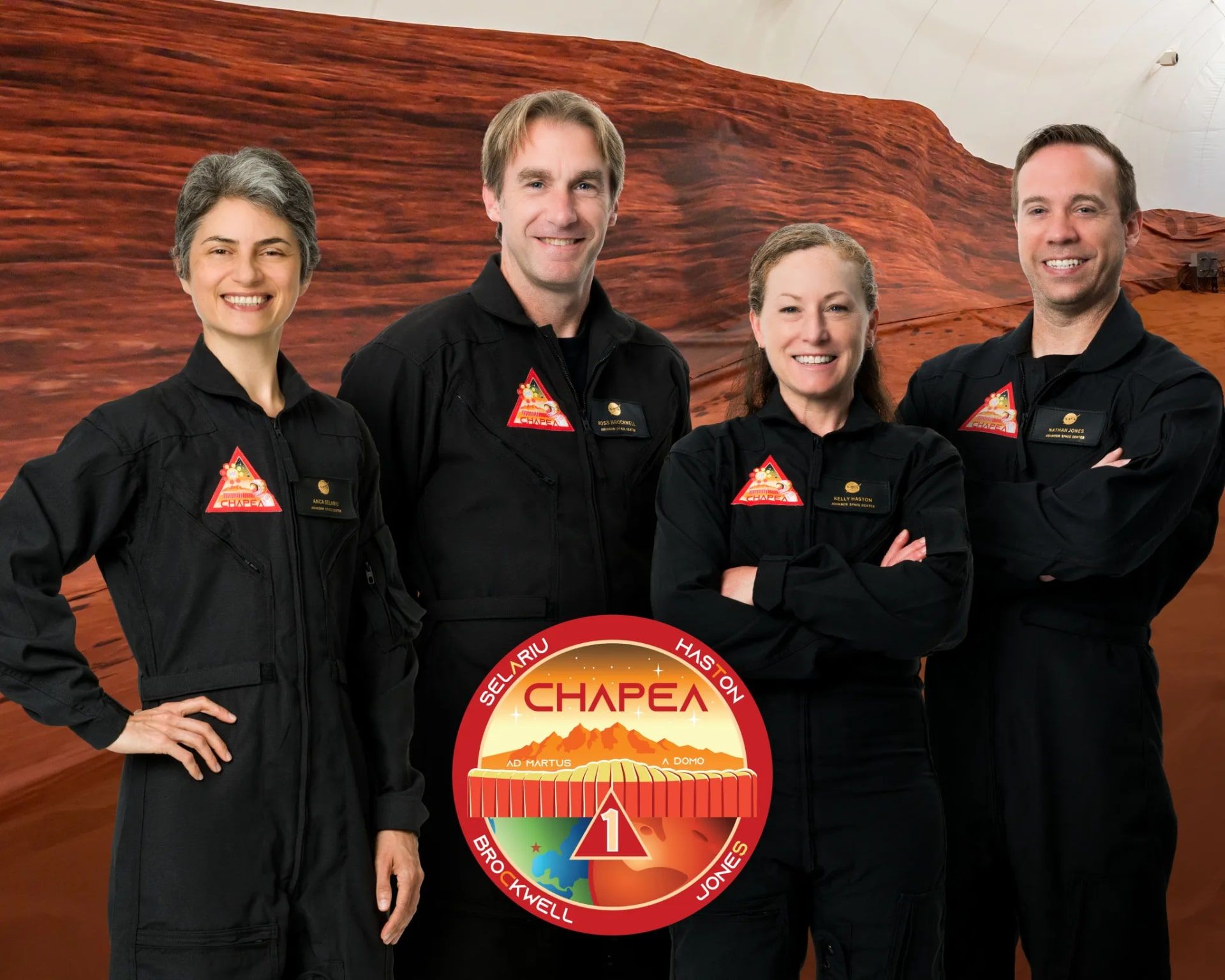 NASA released the official CHAPEA 1 crew portrait on June 25, 2023. From left to right: Anka Selario, Ross Brockwell, Kelly Heston, Nathan Jones.
NASA released the official CHAPEA 1 crew portrait on June 25, 2023. From left to right: Anka Selario, Ross Brockwell, Kelly Heston, Nathan Jones.
The four crew and two surrogates of the CHAPEA mission gathered together for a final month of training and evaluation a month before confinement to the settlement. Three weeks before arrival, NASA hosted a “Family Weekend” for the crew’s loved ones. Families visited the Johnson Space Center and interacted closely with the astronauts. The crew’s families agreed to share stress management techniques and pledged to keep in touch through a private Facebook page.
But Alyssa Shannon received a call five days before the mission began. He announced that NASA had removed him from the mission and had been replaced by U.S. Navy microbiologist Anka Selario. The reason for Alyssa’s removal was not released, but NASA investigators added that sometimes during final pre-mission tests, problems are found that are not “medically serious” but may pose a risk, such as an increased risk of kidney stones. Of course, this is just an example and the researchers refused to provide information.
On June 25, 2023, NASA’s YouTube channel broadcast footage of four CHAPEA 1 crew members standing on a platform in front of the settlement. Grace Douglas announced that the knowledge we gain here will help us send humans to Mars and return them home safely. Then, Douglas opened the simple white door of the settlement, the crew waved and entered. Douglas closed the door behind them. The happy voice of the crew could be heard from inside the settlement


You may like
-

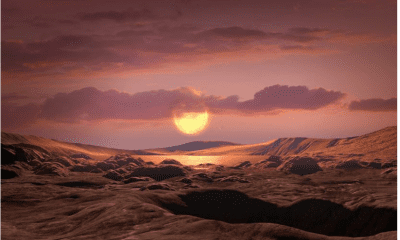


Most alien planets probably do not have day or night
-




The biography of Edwin Hubble
-

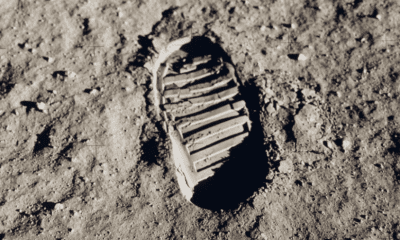


Can telescopes see astronaut footprints on the moon?
-




Can you really see the Great Wall of China from space?
-

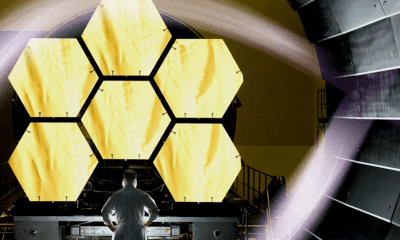


The James Webb Space Telescope; A look at the vastness of the universe
-

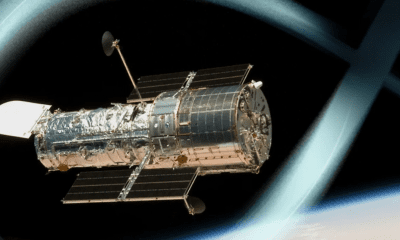


Hubble Space Telescope; A portal to the mysterious depths of the universe


Most alien planets probably do not have day or night
Do aliens sleep? You may take sleep for granted, but research suggests that many possible life-hosting planets may not have a day-night cycle. It is difficult to imagine the absence of day and night, but right now on Earth there are creatures living in lightless habitats in the depths or on the seabed, and they offer a vision of alien life without the existence of a circadian rhythm.
There are billions of potentially habitable planets in our galaxy; But how do we get to this number? The Milky Way has between 100 billion and 400 billion stars, seventy percent of which are cold and small red dwarf stars or M dwarfs.
According to a detailed survey of exoplanets in 2013, approximately 41% of red dwarf stars have a planet in their life belt. At this distance, the planet has the right temperature to support liquid water; Therefore, these planets have the potential to host liquid water.
We still do not know which of the discovered exoplanets have liquid water. However, 28.7 billion planets are only in the red dwarf life belt. We have not even considered the statistics of other types of stars like our sun.
 Planets close to red dwarfs are fatally locked to their star
Planets close to red dwarfs are fatally locked to their star
Rocky planets in the habitable belt of an M dwarf are called M Earths. M-Earths are fundamentally different from our Earth. One difference is that M dwarf stars are much cooler than our Sun. Also, M Earths are located at a close distance from their star, and for this reason, the gravitational influence of the star on them is strong.
The star’s gravity exerts a stronger force on the near side of the planet than on the far side. By creating friction, the planet’s rotation slows down until its orbital and translational rotations become synchronized over millions of years. Thus, M fields are likely to be deadlocked; So that one hemisphere of them is always facing the star and the other hemisphere is always behind it.
The year of a mortally locked planet is as long as its day. Earth’s moon also has a deadly lock on us. For this reason, we always see one side of it and cannot observe its hidden side.
A planet in mortal lock looks strange, But most possible habitable planets are of this type. Our nearest planetary neighbor, Proxima Centauri b, located in the Alpha Centauri system four light-years from Earth, is likely a fatally locked M-Earth.
As a result, unlike our Earth, M Earths have no day or night and even seasons; But terrestrial life, from bacteria to humans, has circadian rhythms corresponding to the day and night cycle. Sleep is one of the most obvious consequences of circadian rhythm.
On Earth, some creatures live in absolute darkness
The circadian cycle affects biochemistry, body temperature, cell regeneration, behavior, and much more. For example, people who are vaccinated in the morning produce more antibodies than people who are vaccinated in the afternoon; Because the response of the immune system is different during the day.
We cannot yet say with certainty how much periods of inactivity and regeneration affect life. Perhaps organisms that evolved without cyclical time never needed to rest.
If you doubt it, you can look at terrestrial organisms such as cave dwellers, deep sea life, and microscopic organisms in dark environments such as the earth’s crust and the human body that thrive in space away from daylight.
Many life forms have biological rhythms that are synchronized to stimuli other than light. Naked burrowing mice spend their entire lives underground and never see the sun, But their day and night hours are proportional to the daily and seasonal cycles of temperature and rainfall. Also, deep-sea bivalves and thermal well shrimps coordinate with ocean tides.
Bacteria that live in the human gut synchronize with melatonin fluctuations in the host’s body. Melatonin is a hormone in the body that is produced in response to darkness. Temperature changes that occur in thermal wells, humidity fluctuations chemical changes, and environmental currents can all cause biological fluctuations in the body of living organisms.
According to new research, M-Earths can have alternate cycles for days and seasons. To evaluate days and seasons on exoplanets, scientists have adapted climate models to simulate the environment of M-Earths and planets such as Proxima Centauri b.
According to the simulations, the contrast between the night and day sides of the planets produces gusts and atmospheric currents similar to Earth’s gust currents. If a planet has water, its dayside is likely to have thick thunderclouds.
The interaction between winds, atmospheric waves, and clouds can change the climate and produce regular cycles of temperature, humidity, and rainfall. The length of these cycles varies from hundreds to thousands of Earth days depending on the state of the planet, But it has nothing to do with the rotation period of the planet. Although the stars in the sky of these planets remain constant, the environment changes.
Perhaps life on M-Earths evolved to match biological rhythms and climatic cycles, or perhaps evolution arrived at a more exotic solution. One can imagine species that live on the day side of the planet going to the night side to rest and regenerate themselves.
These descriptions remind us that if life is out there, it can challenge assumptions we don’t know exist. The only certainty is that it will surprise us.


nameNoun: Any nounal word or phrase which indicates a particular person, place, class, or thing.
Noun: reputation.
Noun: An abusive or insulting epithet.
Noun: A person (or legal person).
Noun: Those of a certain name; a race; a family.
Noun: authority; behalf.
Noun: A unique identifier, generally a string of characters.
Noun: An investor in Lloyd’s of London bearing unlimited liability.
Verb: To give a name to.
Verb: To mention, specify.
Verb: To identify as relevant or important
Verb: To publicly implicate by name.
Verb: To disclose the name of.
Verb: To designate for a role.
Verb: To initiate a process to temporarily remove a member of parliament who is breaking the rules of conduct.
Noun: Any of several types of true yam () used in Caribbean Spanish cooking.
SProper noun: in which several of the axioms of ZF are derivable as theorems.
Noun: Any nounal word or phrase which indicates a particular person, place, class, or thing.
Noun: reputation.
Noun: An abusive or insulting epithet.
Noun: A person (or legal person).
Noun: Those of a certain name; a race; a family.
Noun: authority; behalf.
Noun: A unique identifier, generally a string of characters.
Noun: An investor in Lloyd’s of London bearing unlimited liability.
Verb: To give a name to.
Verb: To mention, specify.
Verb: To identify as relevant or important
Verb: To publicly implicate by name.
Verb: To disclose the name of.
Verb: To designate for a role.
Verb: To initiate a process to temporarily remove a member of parliament who is breaking the rules of conduct.
Noun: Any of several types of true yam () used in Caribbean Spanish cooking.
The biography of Edwin Hubble, the legendary astronomer who discovered the extragalactic space
Edwin Powell Hubble known as Edwin Hubble was a famous American astronomer who played an important role in formulating the basic principles of extragalactic and observational astronomy. Historians and astronomy experts consider him one of the most important astronomers in history. Hubble placed the space clouds, which before her time were known as gas and dust particles and were in the category of nebula or nebula, in the category of galaxies.. Historians consider Hubble’s discovery of other galaxies equal to Copernicus’ theory in terms of scientific value. Copernicus proved that the Earth is not at the center of the solar system, and Hubble proved that the Milky Way is not the center of the universe.
One of the important scientific relics of this astronomer is Hubble’s law in space. In short, this law states that the universe is expanding at a constant rate. In addition, in this law, the distance of each galaxy from the edge of the universe is directly proportional to its speed. Of course, this law was discovered two years before Hubble’s presentation by Georges Lemaitre, but its fame came to Hubble. The Hubble telescope is one of the most famous monuments built in the name of this legendary astronomer. An example of this telescope is installed in his hometown of Marshfield, Missouri. This telescope was sent into Earth orbit in 1990 to capture more detailed images of space outside the Milky Way.
Edwin Hubble has another great achievement in the field of cosmology and that is the classification of galaxies. This classification has been used by astronomers for many years. Hubble played a significant role in adding the astronomy category to the Nobel Prize. Of course, the sudden death of this scientist in 1953 prevented him from receiving this award.
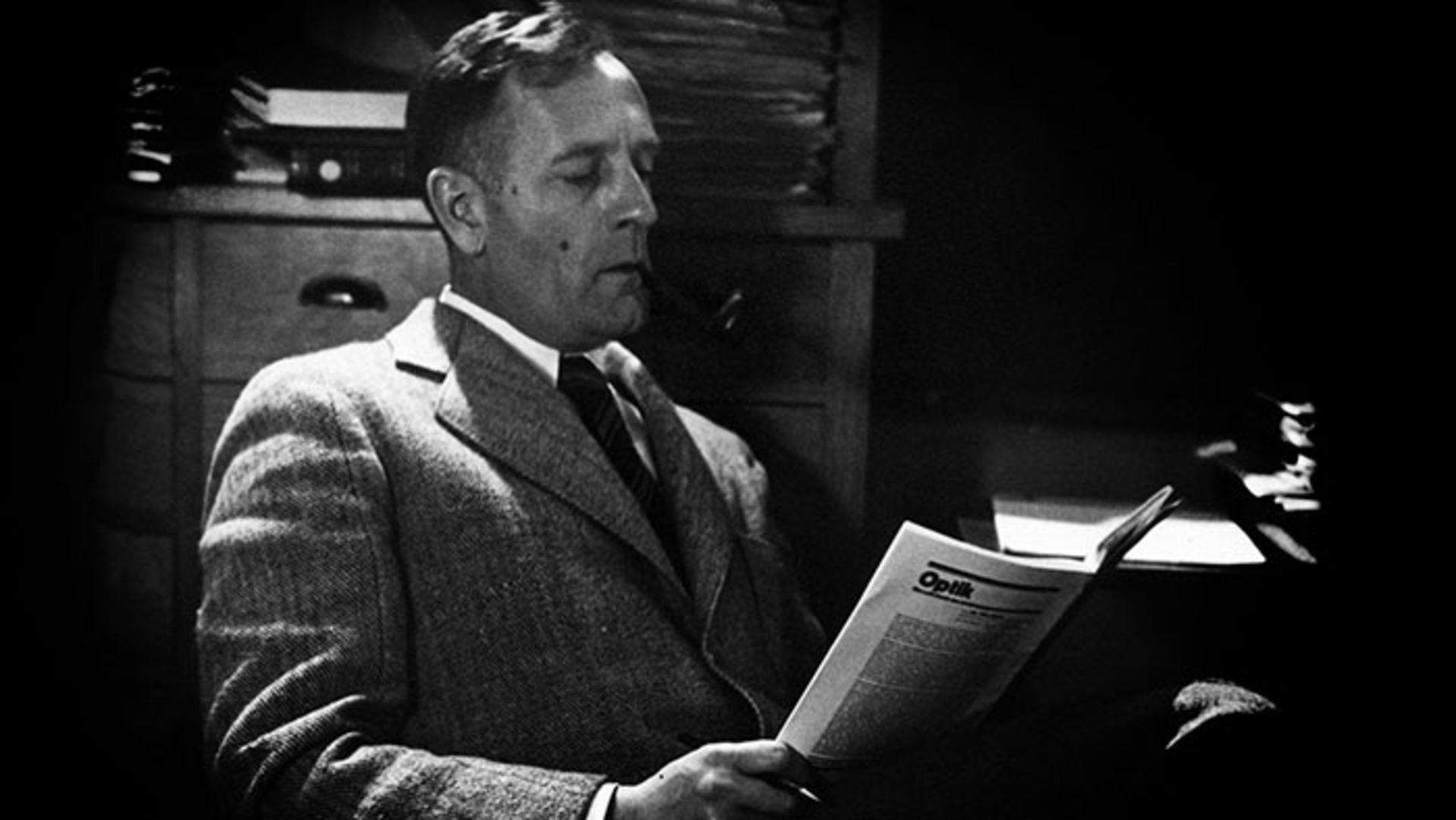
Birth and education
Edwin Hubbell was born on November 20, 1889, in Marshfield, Missouri. His mother was Virginia Lee James and his father was John Powell Hubble. His father was a lawyer and insurance businessman. Edwin was the third child out of 8 children in this family. Of course, like many children of those years, some of Edwin’s siblings died in childhood.
Hubbell lived in a rich family that had to migrate many times because of his father’s work style. During these trips, which were generally in cities around Chicago and Illinois, they lived in luxurious houses with many servants. The children of the Hubble family were all brought up with work and responsibility; Because their parents believed that this style of upbringing would increase their sense of responsibility.
Edwin Hubble was very interested in sports as a child and teenager
As a child, Edwin struggled to keep up with his older siblings and students, so he learned to read before school. He was very fond of adventure books by Jules Verne and H. Rider Haggard. Edwin’s grandfather was an amateur but enthusiastic astronomer. At the age of 7, he got acquainted with one of his grandfather’s telescopes and had his first experience of space exploration. The interesting thing is that instead of participating in the celebration, he observed the space with this telescope on his 8th birthday.
Hubble completed his high school education at Wheaton High School near Chicago. He finished high school easily and with excellent grades in English, mathematics, biology, chemistry, physics, Latin, and German languages. Of course, in high school, Edwin was more into sports than studying, and he owed his high grades to his innate intelligence. On his father’s advice, he was busy delivering goods on holidays. Finally, Edwin Hubbell graduated from high school in 1906 at the age of 16 and received a scholarship to the University of Chicago. He worked at this university as a laboratory assistant of the famous physicist Robert Millikan (Nobel Prize winner).
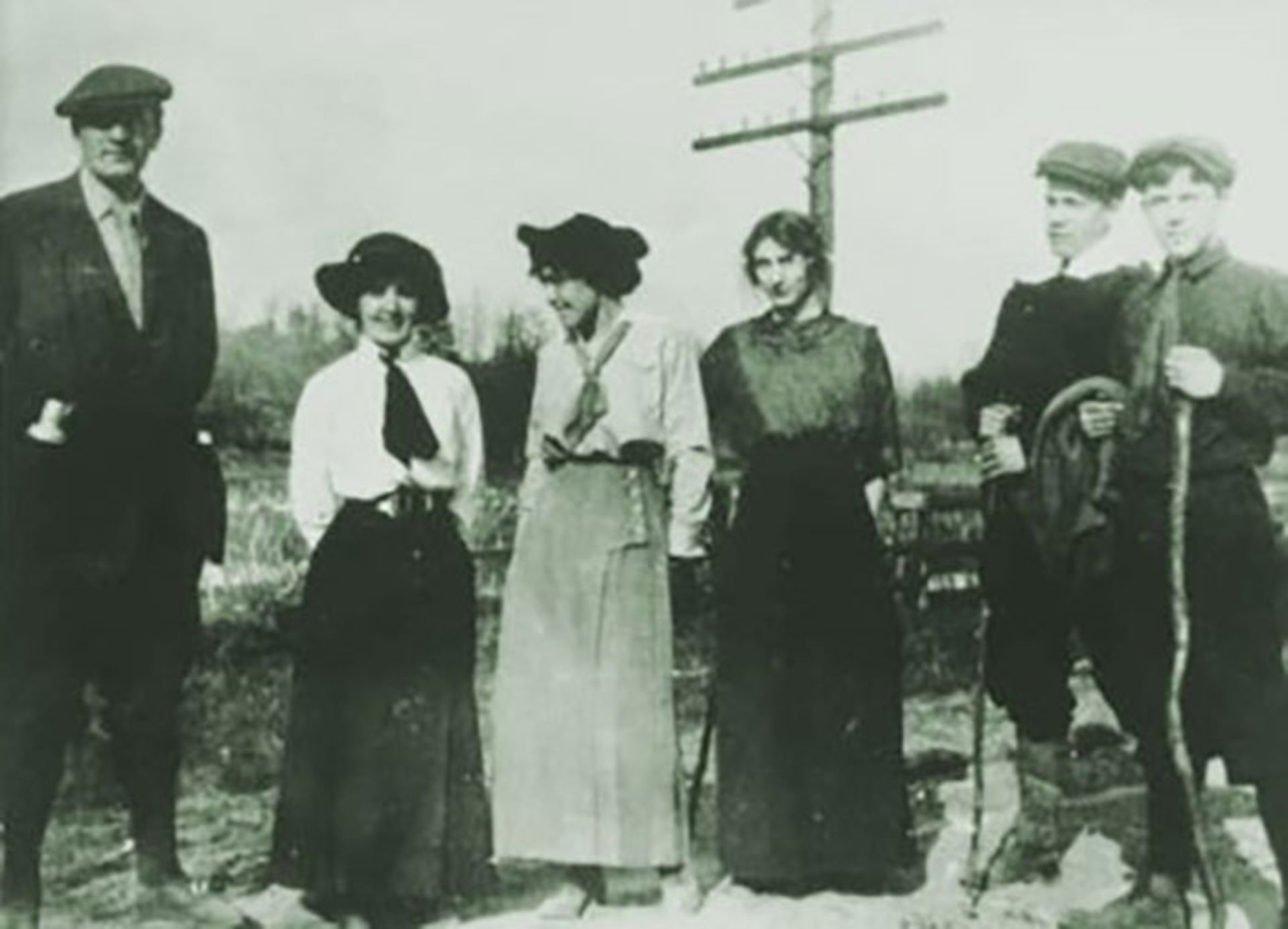
Edwin Hubble (left), with friends after returning from Oxford
After entering the university, sports still occupied a large part of Hubble’s time. He was fond of sports such as basketball and boxing. He was a tall and strong person and he left several records during his university days. Edwin Hubble graduated from the university in 1910 with a bachelor’s degree in general science and honors in physics and astronomy.
After graduating from the University of Chicago, Hubbell entered Oxford University with a Rhodes scholarship and studied there for three years. Hubble was quickly influenced by English culture and changed many of his past behaviors and habits and adopted an English appearance. Contrary to his strong interest in experimental sciences and especially astronomy, he chose the field of law theory out of respect for his father and graduated from Oxford in 1912. He stayed at this university for another year and studied Spanish. While studying at Oxford, Hubble had another achievement including traveling around Europe. In these trips, in addition to having fun, he paid special attention to planning and thinking about his future. In those years, Edwin wrote in a letter to his mother:
Work is pleasant when it is for a great purpose and end. A goal so great that the thought of it and the anticipation of its achievements, will remove all the fatigue of the difficult task. When I find the purpose and principles I want, I leave everything for it and dedicate my life to it.
Edwin’s father died in the fall of 1912. He asked his father for permission to leave Oxford to visit him but was refused. Young Edwin remained in Oxford and his father died in January 1913.
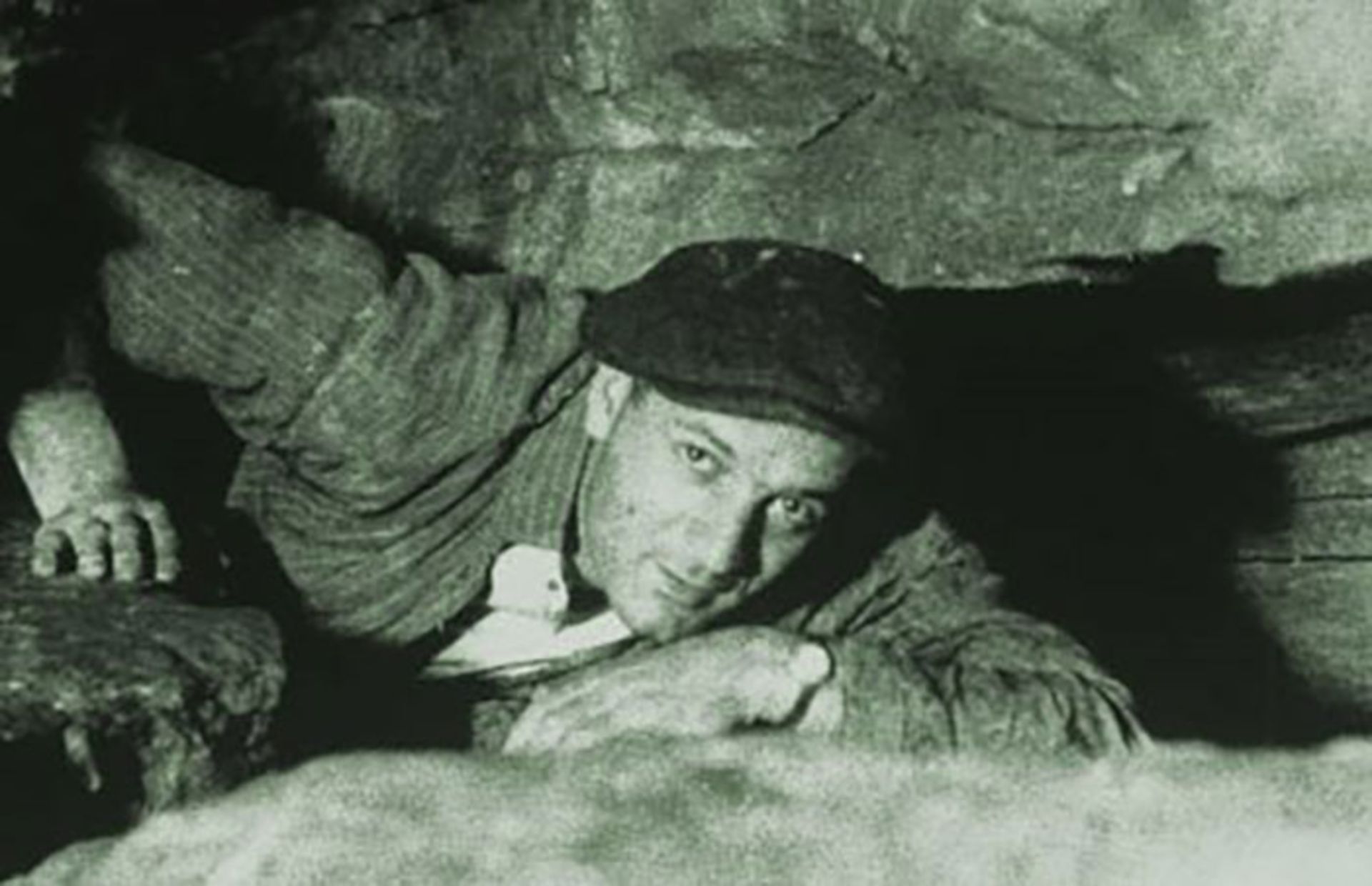
Hubble exploring the cave
His Career
Hubble’s first job was teaching high school Spanish and physics.
Edwin Hubble returned to America in the summer of 1913. He was employed as a Spanish and Physics teacher at New Albany High School in Indiana. In addition, he coached the school’s basketball team and had a part-time job as a German translator. Although Hubble was a popular teacher, he did not enjoy his job. For this reason, he corresponded with Forrest Ray Moulton, professor of astronomy at the University of Chicago, and asked him for advice on collaborating on astronomy projects and higher education in this field. Moulton also introduced Hubble to Edwin Frost, director of the Yerkes Observatory in Wisconsin. In his letter, he introduced Hubble as a hardworking person, enthusiastic about science, and useful to Frost.
Finally, at the age of 24, Edwin entered the field of science, which he had become interested in nearly two decades ago by observing space through the lens of his grandfather’s telescope. Upon entering the observatory, he began his doctoral course in astronomy and received his degree in 1917 with a thesis entitled Photographic Investigations of Faint Nebulae. With the outbreak of World War I, Hubble served in the army for a year and rose to the rank of colonel despite not being actively involved in combat. He then went to Cambridge University to study astronomy.
Edwin Hubble started working at the Mount Wilson Observatory in California in 1919 at the age of 30. This observatory is famous for its excellent weather and excellent observation conditions. These factors made Hubble research in this place until the end of his life.
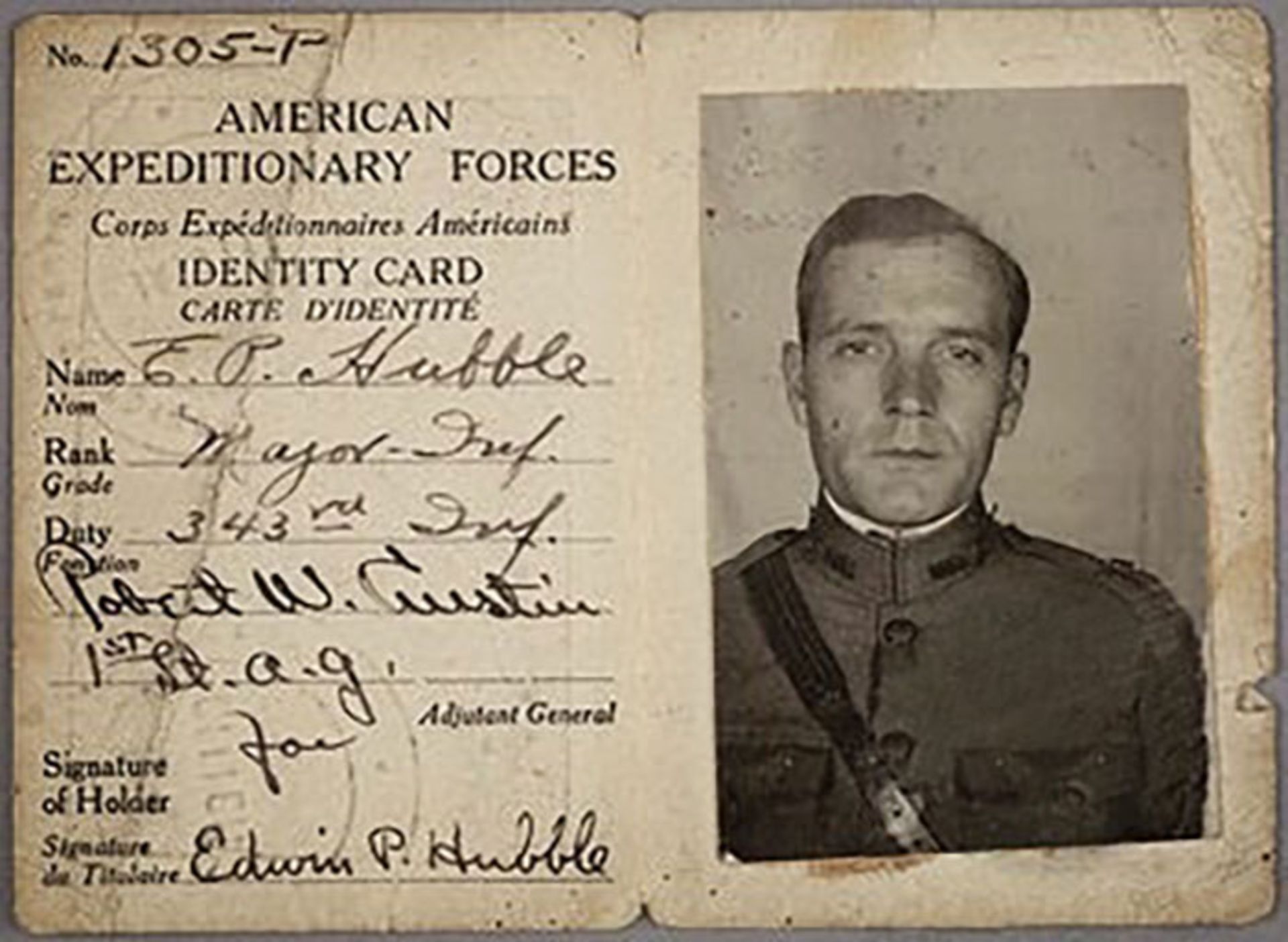
Hubble membership card in the army
Scientific achievements
As mentioned, Hubble wrote his doctoral dissertation on nebulae. He continued his research at Mount Wilson using the world’s largest telescope, the Hooker telescope. Hubble’s great discoveries, including galaxies beyond the Milky Way and the phenomenon of redshift, were the results of this astronomer’s research using the Hooker telescope.
In 1912, the American astronomer Henrietta Leavitt published an important discovery related to stars called the Cepheid variable. Beginning in the 1930s, Hubble was able to discover similar stars in nebulae using the Hooker telescope. While studying the Andromeda Nebula, he realized that these stars are very far from Earth and much farther than the stars of the Milky Way.
The discovery of other galaxies and the greatness of the universe was the greatest achievement of this scientist
Eventually, Hubble discovered that the Andromeda Nebula is actually a galaxy. Until then, most astronomers believed that the Milky Way and the Universe were a single entity. Hubble discovered that the universe is much larger than the Milky Way and consists of “island universes”. His findings in this historical discovery are summarized as follows:
- His high-quality images of Andromeda and the Triangulum Nebula showed a massive cluster of stars.
- Many of the stars were of the Cephasian type.
- The studied nebula is one million light years away from Earth. 4 times more than all the objects that had been discovered until that time. (Of course, this distance is proven to be equal to 2.5 million light-years today.)
- The diameter of the Andromeda Nebula is 30 thousand light years. (Today, these dimensions have been proven to be 220,000 light years.)
- Andromeda galaxy emits light equal to one billion suns of our system.
Hubble published his findings three days after his 35th birthday. Of course, his discoveries were not published in a scientific journal, but in the New York Times. The results of his research were debated among astronomers for some time, and finally, his paper was reviewed at the meeting of the American Astronomical Society on January 1, 1925. Hubble changed everyone’s view of the universe with his discoveries. He proved that our vast galaxy, host to the Sun and hundreds of billions of similar stars, is only one of the billions of galaxies in the universe.

Andromeda Galaxy
In addition to this discovery, Hubble provided a standard for classifying galaxies that was used by astronomers for years.
Redshift phenomenon
Prominent astronomer Veslu Slifer has also researched nebulae. He stated in his report in 1913 that the light of the nebula tends towards the red color of the color spectrum. He explained his discovery as a form of the Doppler effect. According to the same explanation, the light tends to the red side of the color spectrum as the emission source moves away, similar to the Doppler effect. To test his discovery, Slifer studied many nebulae. He came to the conclusion that the light of many of these nebulae has a fast transition towards red color and as a result, they are moving away from Earth at a high speed.
Hubble stated that galaxies are moving away from each other at high speed
In 1929, using Slifer’s findings and combining them with his own discoveries and his assistant Milton Humson’s, Hubble was able to find an explicable relationship between galaxy distance and redshift state. He recorded his findings in a formula known today as Hubble’s law. This formula is displayed as v = Hr, where v is the velocity, r is the distance, and H is Hubble’s constant. This constant was first named as 530 by Hubble, but today, using advanced research and tools, the exact number is 70.
The world is expanding
One of the main interpretations of Hubble’s law is that we live in an expanding universe. Of course, Hubble himself believed that there is not enough credible evidence to prove this interpretation of the redshift effect. The remarkable point is that although Hubble drew the attention of the scientific community to this law, the law was discovered two years earlier by Georges Lemaitre. In fact, Lemaitre’s interpretation of this law is more accepted by new cosmologists; Because he used Einstein’s law of relativity for his interpretation.
However, Hubble’s point of view was quite logical. He believed that the theory of red shift can only be accepted as a proof of the expansion of the universe when the density of matter in the universe is much higher than the amount discovered up to that time. These statements have been the basic foundations for the proof of dark matter in the universe. Hubble said about the density of materials needed to prove the effect of redshift:
The required density of matter is several times higher than the estimated maximum density of matter concentrated in the nebula. Furthermore, we have no evidence of significant interstellar matter increasing the density.

Classification of galaxies by Hubble
However, although Hubble had a lot of resistance to accept the effect of redshift, in his research he found that the speed of this expansion is slowing down. However, these findings and research on the speed of galaxy expansion are still ongoing and astronomers discover new issues every day.
One of the historical events regarding the theory of the expanding universe is Albert Einstein’s meeting with Edward Hubble in 1931. The two met at Mount Wilson Observatory. In 1917, in his theory of relativity, Einstein considered the universe to be constant and without change in size. He did not see any end or end to the universe. Although his research showed signs of the expansion of the universe, this scientist tried to deny it by determining a constant called the cosmic constant.
However, the January 1931 meeting earned Hubble the nickname of the man who forced the world’s smartest man to change his mind. This meeting caused Einstein to call his previous calculations the biggest mistake of his scientific life, and as a result, Hubble’s findings became the center of attention in scientific circles.
The Big Bang theory is influenced by the findings of this scientist about the expansion of the universe
In 1935, Hubble discovered the 1373 asteroid named Cincinnati. A year later he published the book ” The Realm of the Nebulae “. This book is a historical interpretation of his experiences and research on intergalactic astronomy. With the outbreak of World War II, Hubble once again served in the US Army at the Aberdeen Proving Ground. He was in charge of the ballistics research department in this area. His extensive research resulted in several improvements in the power of ballistic bombs and projectiles. One of his major practical achievements in this research was the improvement of ballistic projectile components, which resulted in a high-speed camera to study the characteristics of the bomb after launch. After the war, Hubble returned to Mount Wilson and spent some time at the Palomar Observatory in California.

Edwin Hubble in old age
In addition to scientific research, Edwin Hubble worked hard to convince the Nobel Prize Society to add astronomy to the award’s branches. He intended to add this science to this event as an independent subsection of physics. He believed that the efforts of astronomers in stellar physics should be appreciated. Unfortunately, after Hubble’s death, this society decided to appreciate this science as a branch of physics.
Personal life and death
Edwin Hubbell married Grace Burke Leib in 1924 at the age of 34 . They had no children. One of Hubble’s pastimes was collecting books. He was generally interested in books related to the history of science. In addition to scientific research, Hubble was also a member of the Board of Trustees of the Huntington Library in San Marino. The discovery of distant galaxies made him so famous that in 1948 his picture appeared on Time magazine. He and his wife had a close relationship with Hollywood stars and artists such as Aldous Huxley.
In 1949, at the age of 59, Edwin Hubbell suffered a heart attack while on vacation in Colorado and was nursed back to health by his wife. Of course, after this incident, the intensity of his research activities decreased until he died on September 28, 1953, due to a blood clot in the brain. He had willed that his burial place should not be known and personal notes were also destroyed by his wife. Grace also died in 1980 and was buried in a secret place next to her husband.
Awards and honors
The Cleveland Newcomb Prize was awarded to Edwin Hubble in 1924. In 1938, he was awarded the Bruce Medal, and a year later, he was awarded the Franklin Medal Science and Engineering Award by the Franklin Institute in Philadelphia. The Gold Medal of the British Royal Astronomical Society was awarded to this legendary astronomer in 1940. The Legion of Honor, which is a military award from the US Armed Forces, was awarded to him in 1946 for his research in the field of ballistics.

Hubble Space Telescope
After the death of Edwin Hubble, in addition to the aforementioned awards, other honors were also registered to pay tribute to this American scientist. The Missouri City Hall of Fame inducted Edwin Hubbell in 2003. In 2008, a commemorative stamp was printed in the name of this scientist, and in 2017, the Indiana Basketball Hall of Fame registered Hubble’s name.
Asteroid number 2069 and a hole in the moon are among the celestial objects that are registered in the name of this scientist. A planetarium at Edward R. Morrow High School in Brooklyn was also named after this scientist, and a street in Missouri was named after Edwin Hubble.
Certainly, the most famous monument of Edwin Hubble is the Hubble Space Telescope, which was launched in 1990. The main purpose of launching this telescope was to accurately calculate Hubble’s constant in his famous formula. Anyway, astronomers with this telescope first considered the number 72 as a constant in 2001, and then in 2006, by studying the microwave background of the galaxy, they reached the exact number 70. In addition, the Hubble telescope made it possible to observe not only the expansion of the universe but also the acceleration of this expansion. Today, the force that caused this expansion is called dark energy in scientific documents.


Can telescopes see astronaut footprints on the moon?
In the early 2000s, when there were occasional people who believed that the moon landing was a hoax, the argument was made that if NASA’s Hubble Space Telescope was powerful enough to see the tiny details of distant galaxies, why couldn’t it take the shoes of the Apollo astronauts on the moon?
The aforementioned argument, like many conspiracy theories, seems convincing on the surface; But with the slightest scrutiny, it loses its value. Those who are fooled by this claim are wrong about two things: how telescopes work and how big space is.
Astronomer Phil Platt explains on the Scientific American website that many people think a telescope’s job is to magnify images. Of course, manufacturers of cheap telescopes like to advertise them this way, printing statements like “150x magnification power” in big letters on the box of the telescopes, along with very misleading pictures of much larger telescopes. Although magnification is important, the true power of a telescope is in its resolution. This difference is subtle but very important.
Magnification is how much you can focus on an object and make it appear larger. This is important because while astronomical objects are physically very large, they are very far away and thus appear small in the sky. Magnifying them makes them easier to see.
Magnification is important, but the true power of a telescope is in its resolution
On the other hand, clarity or resolving power is the ability to differentiate between two objects that are very close together. For example, you might think of two stars orbiting each other (a binary star) as one star; Because their distance is very small and the naked eye cannot distinguish them. But if you look at them with a higher-resolution telescope, you may be able to see that they are two separate stars.
Isn’t that the Zoom? No; Because zooming in only makes everything bigger. This can be easily illustrated with the following image: zoom in as much as you want on the image, but once you pass a certain limit, you only enlarge the pixels and get no new information. To overcome this obstacle, you need to have high resolution rather than zoom.
 Hubble Space Telescope image of the Apollo 17 landing area in the Taurus-Lytro Valley of the Moon. This image lacks the necessary resolution to show the traces of the moon landing or the movement of astronauts on the moon.
Hubble Space Telescope image of the Apollo 17 landing area in the Taurus-Lytro Valley of the Moon. This image lacks the necessary resolution to show the traces of the moon landing or the movement of astronauts on the moon.
The problem is that resolution depends on the telescope itself, meaning that a dramatic increase in resolution usually requires a much larger telescope; But no matter how big your telescope gets, it will still have limited resolution.
When light from an infinitesimal point, such as distant stars, passes through a telescope, the light is slightly scattered within the telescope’s optical instruments (mirrors or lenses). This fundamental property is called light diffraction and is unavoidable. The resolution of telescope images depends partly on the size of its mirror or lens. The larger the telescope’s light-gathering instrument, the higher its image resolution.
The way light propagates in optical equipment depends on wavelength, with shorter wavelengths producing higher resolution. So two nearby blue stars may be distinguishable in a telescope, while two red stars at the same distance may not be distinguishable.
When deciding on the size of a telescope’s camera pixels, astronomers must consider the wavelength they want to observe. Otherwise, they just magnify the noise; Like the previous example about zooming too much on the photo.
All these lead to an amazing result. The Hubble Space Telescope has a mirror with a diameter of 2.4 meters and the James Webb Space Telescope (JWST) has a mirror with a diameter of 6.5 meters. Therefore, the resolution of the James Webb telescope images can be expected to be much higher. At some wavelengths, it is: the shortest wavelength that the James Webb Space Telescope can see is about 0.6 microns (what our eyes perceive as orange light), and the resolution is technically much better than that of the Hubble image.
However, the James Webb Space Telescope was designed as an infrared telescope. At those wavelengths, say around two microns, the resolution is comparable to what Hubble can see at visible light wavelengths. In the mid-infrared, i.e. wavelengths of 10 to 20 microns, the resolution of the James Webb Space Telescope images is even lower. However, because the James Webb is the largest infrared telescope ever sent into space, it can provide the sharpest images we’ve ever had at these wavelengths.
 No telescope on Earth or in low Earth orbit can capture an image like this, a high-resolution view of a boot on the moon’s surface.
No telescope on Earth or in low Earth orbit can capture an image like this, a high-resolution view of a boot on the moon’s surface.
Astronomers measure resolving power as an angle on the sky. From the horizon to the highest point of the sky is 90 degrees and each degree is divided into 60 arc minutes and each arc minute into 60 arc seconds. For example, the angular diameter of the moon from our point of view in the sky is about half a degree. That is, if we look at the moon from the Earth, the moon in the sky occupies a space equal to half a degree of the full circle of the sky, which is equivalent to 30 minutes of arc or 1800 seconds of arc.
The maximum resolution of a telescope refers to the smallest angular distance between two objects that the telescope is able to distinguish as two separate objects. This resolution is expressed as an angle.
At its best, the resolution of the Hubble telescope is about 0.05 of an arc, which is considered a very small angle. But the amount of detail Hubble is able to see depends on the distance and physical size of the target. For example, 0.05 seconds of arc is equivalent to the apparent size of a small coin that can be seen from about 140 km.
In this way, we return to the discussion of conspiracy theorists and their claims regarding the observation of astronaut footprints on the moon. Galaxies are usually tens of millions or even billions of light years away from Earth. At those distances, the Hubble telescope can distinguish objects with dimensions of several light years (i.e. tens of trillions of kilometers) with its best resolution. So even though it looks like we’re seeing galaxies in great detail in those amazing Hubble images, the smallest we can see is still pretty big.
At the same time, the moon is only about 380 thousand kilometers away from us and from the Hubble telescope. At this distance, the resolution of the Hubble telescope is surprisingly limited, unable to resolve objects smaller than about 90 meters. As a result, not only can we not see the astronauts’ footprints in the Hubble images, but we can’t even see the Apollo moon landings, which are about four meters across. Hubble’s resolution at this distance is so limited that it cannot distinguish details smaller than about 90 meters, so it is not possible to see objects smaller than this on the Moon.
 An image of the Apollo 11 landing site captured by NASA’s Lunar Reconnaissance Orbiter (LRO). Although the LRO telescope uses much smaller lenses than the Hubble Space Telescope, its proximity to the lunar surface has made it possible to see details such as the Apollo 11 lunar lander and astronauts’ footprints.
An image of the Apollo 11 landing site captured by NASA’s Lunar Reconnaissance Orbiter (LRO). Although the LRO telescope uses much smaller lenses than the Hubble Space Telescope, its proximity to the lunar surface has made it possible to see details such as the Apollo 11 lunar lander and astronauts’ footprints.
In the images taken by the Nass Lunar Reconnaissance Orbiter (LRO), we can see the moon landings and the footprints of the astronauts. Although the camera of this orbiter has a mirror with a diameter of only about 20 cm, the spacecraft is in lunar orbit and passes the Apollo landing sites at an altitude of 50 km.
The reason NASA’s Lunar Reconnaissance Orbiter can see more detail on the surface of the moon is because it is so close to the surface of the moon. This is why we send probes to planets: it allows us to get much better pictures of them. Sometimes, there’s no substitute for being there.
The lesson we learn from this topic is that the way tools actually work is often more complex and different than we expect. Furthermore, claims that may seem reasonable fall apart with a little scientific scrutiny. If a telescope is only advertised based on magnification, it’s best not to buy it and look for other options. It may seem difficult, but with a little determination, you will succeed.


Do animals have an understanding of the concept of death?


What is Kali Linux? Everything you need to know about this popular but mysterious distribution


Sony Brand Story; From the production of rice cookers to becoming one of the most famous companies in the world


How did the people of the past imagine the future?


Mammoth and dodo return to nature


Canopus; What do we know about the second brightest star in the sky?


How to use iMessage on Android?


Can humans endure the psychological torment of living on Mars?


Xiaomi Glorimi M2 Max watch review; Alternative economic option for iPhone owners


Artificial intelligence problems; Frauds based on artificial intelligence and methods to deal with them
Popular
-



 Technology1 year ago
Technology1 year agoWho has checked our Whatsapp profile viewed my Whatsapp August 2023
-



 Technology1 year ago
Technology1 year agoSecond WhatsApp , how to install and download dual WhatsApp August 2023
-



 Technology1 year ago
Technology1 year agoHow to use ChatGPT on Android and iOS
-



 AI2 years ago
AI2 years agoUber replaces human drivers with robots
-



 Technology1 year ago
Technology1 year agoThe best Android tablets 2023, buying guide
-



 Technology1 year ago
Technology1 year agoThe best photography cameras 2023, buying guide and price
-



 Humans2 years ago
Humans2 years agoCell Rover analyzes the inside of cells without destroying them
-



 Technology1 year ago
Technology1 year agoHow to prevent automatic download of applications on Samsung phones
